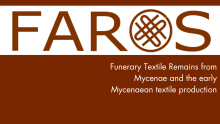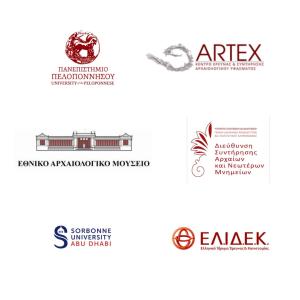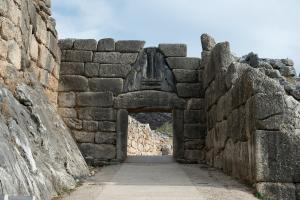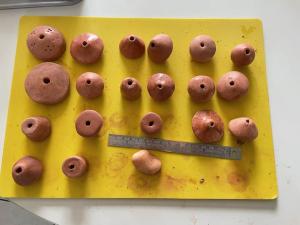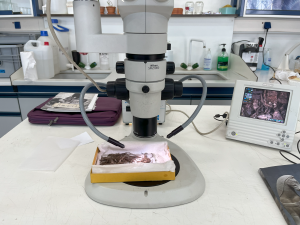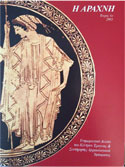Unravelling Mycenaean Threads: The FAROS Project
The Fabric of Kings: Funerary textile remains from Mycenae and the early Mycenaean textile production.
We are thrilled to announce that ARTEX has embarked on a remarkable journey into the depths of the Mycenaean civilization as a vital partner in the FAROS project.
Project Overview
The Fabric of Kings: Funerary textile remains from Mycenae and the early Mycenaean textile production (FAROS), hosted by the University of the Peoponnese, is set to shed new light on the early Mycenaean textile culture. This ambitious initiative, funded by the Hellenic Foundation for Research and Innovation (H.F.R.I.) and spanning from 2023 to 2025, is a collaborative effort involving several research and cultural institutions from Greece and abroad, with ARTEX playing a pivotal role. It endeavours to explore a lesser-known chapter in the history of ancient Greek civilization – the textile culture of the early Mycenaean era. Rather than the golden masks and grand palaces, our journey begins with the intricacies of funerary textiles buried alongside the Mycenaean elite. These textiles, often overshadowed by the grandeur of royal artifacts, may hold the secrets of early Mycenaean textile production.
Background
Over the past two decades, textile archaeology has gained momentum across Europe and the Mediterranean region. In Greece, institutions like the Hellenic Centre for Research and Conservation of Archaeological Textiles (ARTEX) and the Textiles Conservation Lab of the Directorate of Conservation of Ancient and Modern Monuments have intensified research efforts. However, while there is a wealth of knowledge about the later phases of the Mycenaean era, such as the Late Helladic III period, our insights into the initial emergence of this civilisation during Late Helladic I-II, also known as the Shaft Grave Period, are limited. This is where the FAROS project steps in with access to a unique treasure trove – a collection of funerary elite textiles from the 17th to 16th centuries BCE discovered in inhumation graves within Grave Circles A and B at Mycenae. These textiles, often preserved in a remarkable state, have the potential to rewrite the narrative of early Mycenaean textile production.
Research Objectives
Textiles, often underestimated in the past, serve as essential vessels of history, reflecting not only the intricate craftsmanship of their creators but also the evolution of a culture. The FAROS project sets out with specific objectives that weave together the threads of ancient Mycenaean society. The primary goal is to unravel the technical aspects of early Mycenaean textiles, spanning materials, fibre processing, production techniques and decorative methods. These insights will enable us to gain a clearer understanding of their textile industry's early days. Furthermore, FAROS explores the characteristics of textiles associated with the Mycenaean elite during this period. Chosen to accompany the elite in their journey to the afterlife, these textiles are not merely artifacts, but windows into the socio-cultural dynamics of the time. Through meticulous examination, we anticipate profound insights into the role of textiles in expressing elite identity and status. Finally, by comparing the technology of the early Mycenaean period with that of the later palatial era, the project aims to trace the evolution of textile technology, revealing nuanced changes and advancements over time.
Research Methodology
The project's methodological approach combines bibliographic research, macroscopic and microscopic examination, and scientific analyses like High Performance Liquid Chromatography and radiocarbon 14 dating, with ARTEX providing essential support. The FAROS project extends its exploration beyond textiles. Tools, iconography, and Linear B archives are studied to glean insights into Mycenaean textile production. Experimental archaeology comes into play, replicating textile tools and weaving samples on reconstructed looms to test production and decoration techniques. This multidisciplinary approach promises to deepen our understanding of ancient textile culture and its evolution throughout the Bronze Age.
Preliminary Results
The stereoscopic examination of Grave Circle textiles showcases the sophistication of Mycenaean textile production. Fragments used to wrap weapons and proximity to luxury swords with gold embroidery highlight the multifaceted roles of these textiles. Early observations hint at the presence of diverse materials, such as plant and animal fibres, along with varying fabric qualities and decoration techniques. Some textiles even display royal symbols like the use of purple dye and tapestry decorations, a testament to the high level of craftsmanship in the early Mycenaean period. These findings imply that the textiles interred with the Mycenaean elite were of exceptionally high quality, adding credence to the notion of "Polychrysai Mykenai" or "Rich in gold", a frequent Homeric expression.
Research Dissemination and Outreach
FAROS is dedicated to disseminating its extensive research findings to academic communities worldwide. Through scholarly publications, conference presentations, and active participation in international forums, the project contributes valuable insights to the global archaeological discourse. This commitment to dissemination extends beyond academia, as FAROS actively engages in outreach initiatives. Public lectures, workshops, and educational activities are integral to its mission, allowing the project to share archaeological knowledge widely and foster a deeper appreciation for cultural heritage.
Impactful Outcomes and Strategic Social Media Presence
FAROS aims to leave a lasting impact by inspiring future scholars and contributing to the preservation of archaeological textiles. The project's tangible outcomes, focused on the early Mycenaean period, will be consolidated in a comprehensive Digital Textiles Catalogue. Through this Digital Textiles Catalogue, the project ensures valuable insights are available to researchers and that our understanding of ancient textile cultures is significantly enhanced. Complementing its scholarly endeavours, FAROS strategically employs social media platforms. By maintaining an active online presence, the project connects with a broader audience, sharing real-time updates, insights, and behind-the-scenes glimpses. This approach not only enhances research dissemination but also ensures accessibility and interactivity, fostering a dynamic engagement with diverse audiences.
Team Members
The FAROS project brings together a multidisciplinary team with expertise in archaeology, conservation, textile science and digital communications to unravel the secrets of early Mycenaean textile production and share this knowledge with the world.
Dr. Stella Spantidaki, Post-Doctoral researcher and ARTEX’s President, leads the FAROS team as the Principal Investigator of the project with extensive experience in studying archaeological textiles and performing interdisciplinary research. Dr. Spantidaki directs the project and oversees various aspects, including data collection, examination of textile remains, scientific analyses, historical and archaeological research, the project’s management and dissemination and much more.
Dr. Christophe Moulherat Associate Professor of Archaeology and Head of the Department of Archaeology and History of Art, Sorbonne Abu Dhabi. Dr. Moulherat contributes to macroscopic and microscopic textile studies and trains the PI in fibre identification and fibre processing techniques.
Dr. Christina Margariti, Head of the Department of Applied Research at the Directorate of Conservation of Ancient and Modern Monuments within the Hellenic Ministry of Culture and Sports. Dr. Margariti participates in the macroscopic and microscopic textile studies and contributes to the preventive conservation of the textile remains.
Dr. Kalliope Sarri, Post-Doctoral Researcher specialised in prehistoric archaeology, particularly the archaeology of the early Mycenaean period. Dr. Sarri focuses on the archaeological context of textile finds and leads the research on extant textile tools from the early Mycenaean period, along with comparative materials from different periods. Dr. Sarri also directs the experimental archaeology part of the project, producing replicas of ancient textile tools, testing production and decoration techniques on different reconstructed looms and organising hands-on interactive workshops.
Dr. Nikolaos Harokopos, Post-Doctoral Researcher in Classical Archaeology with expertise in textile and garment iconography of the Archaic and Classical periods. In the FAROS project, Dr. Charokopos focuses on the study of textile iconography from the palatial period.
Dr. Georgianna Moraitou, Head of the Department of Conservation, Physical-Chemical Research, and Archaeometry at the National Archaeological Museum. Dr. Moraitou contributes to the preventive conservation of the textile remains by ensuring their proper preservation and storage conditions, in collaboration with Dr. Christina Margariti.
Lia Andreakou, archaeologist, holds the role of Digital Communications Manager and Research Assistant within the FAROS project. Ms Andreakou’s primary contributions include creating digital content and managing FAROS’ social media presence, assisting with project research, management and dissemination, as well as ensuring effective communication with administrative staff and the team members.
Collaborative Institutions
FAROS thrives on collaboration, uniting the combined strengths of various organisations and institutions. The FAROS project collaborates with several esteemed institutions:
National Archaeological Museum, Athens (Greece): The museum houses the textile corpus from Mycenae, a central focus of the project, as well as a number of textile tools. The FAROS project collaborates with the Department of Prehistoric Antiquities for the study of ancient fabrics and textile production tools and with the Department of Conservation and Physical – Chemical Research & Archaeometry of the Museum for the study of the fabrics and their preventive conservation.
Hellenic Centre for Research and Conservation of Archaeological Textiles (ARTEX), Athens (Greece): ARTEX, as a primary collaborator, significantly contributes to the preservation and study of archaeological textiles. Specifically, the archives of old studies of textile remains from the Grave Circle B, the stereomicroscope, and the optical microscope of ARTEX will be used in the macroscopic and microscopic study of textile remains of the project.
Directorate of Conservation of Ancient and Modern Monuments, Hellenic Ministry of Culture and Sports, Athens (Greece): The Directorate is a valuable partner in the project's preservation efforts. Moreover, it provides access at and use of scientific tools for the study of the textile remains.
Sorbonne Abu Dhabi (United Arab Emirates): FAROS collaborates with the Department of Archaeology and History of Art of the Sorbonne Abu Dhabi in the area of the macroscopic and microscopic study of archaeological textile remains.
Advisory Board
Associate Professor Aimilia Banou, University of Peloponnese
Associate Professor Eleni Zimi, University of Peloponnese
Professor Marie-Louise Nosch, University of Copenhagen
Dr Vasileios Petrakis, Independent Researcher
Dr Konstantinos Nikolentzos, National Archaeological Museum
Dr Vasiliki Pliatsika, National Archaeological Museum
Dr Aikaterini Voutsa, National Archaeological Museum
Conclusion
The FAROS project, in collaboration with ARTEX, is a significant undertaking with the mission to unravel the mysteries of early Mycenaean textile culture. With a dedicated team of experts and valuable collaborators, and the support of the Hellenic Foundation for Research and Innovation, this project promises to contribute new insights into ancient Greek civilisation. With a commitment to bridging the past with the present, FAROS explores how textile technology evolved from the Bronze to the Iron Age.
We invite you to join us on this exciting journey into the heart of the Mycenaean world, as we unravel the threads of history one strand at a time.
Stay tuned for more exciting updates and discoveries from the FAROS project!
The research project was supported by the Hellenic Foundation for Research and Innovation (H.F.R.I.) under the “3rd Call for H.F.R.I. Research Projects to support Post-Doctoral Researchers” (Project Number: 7354)

